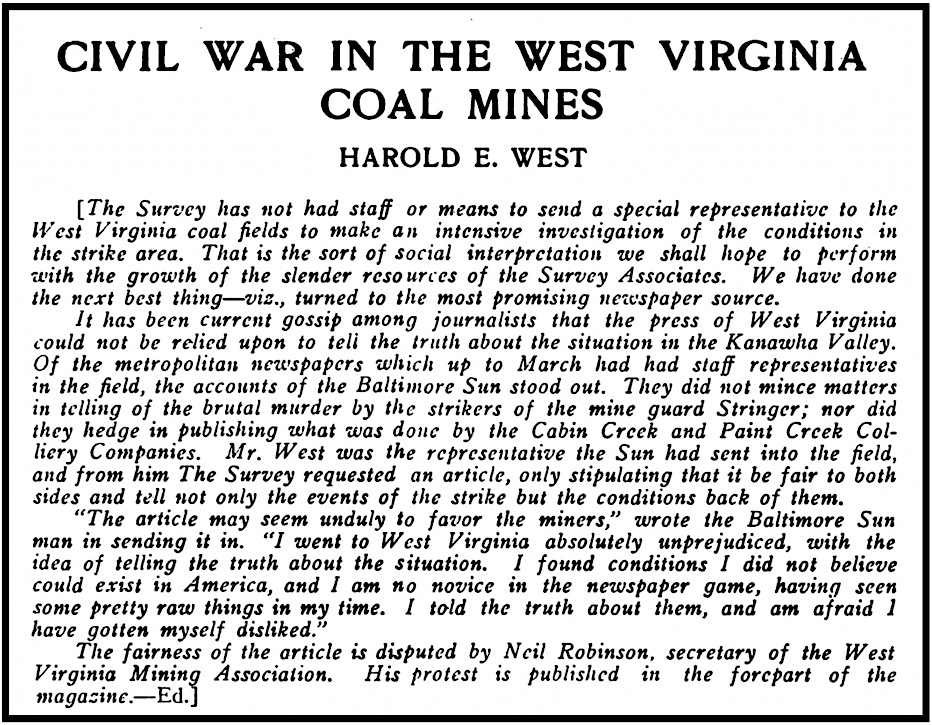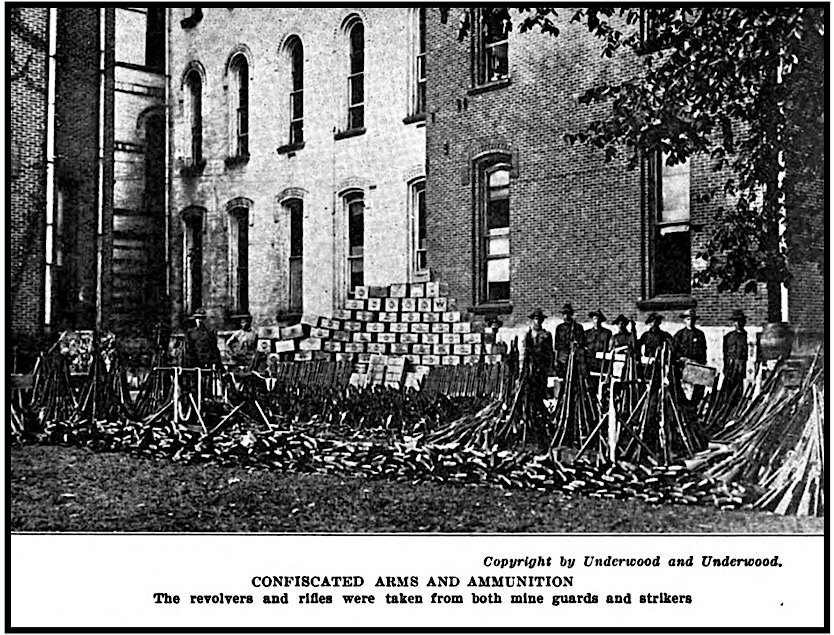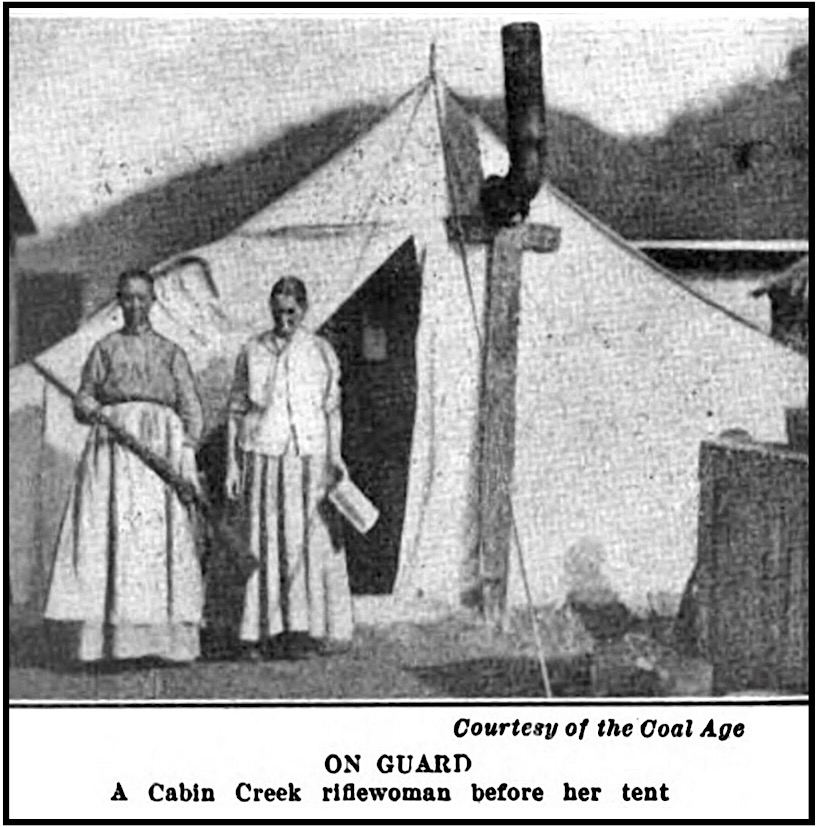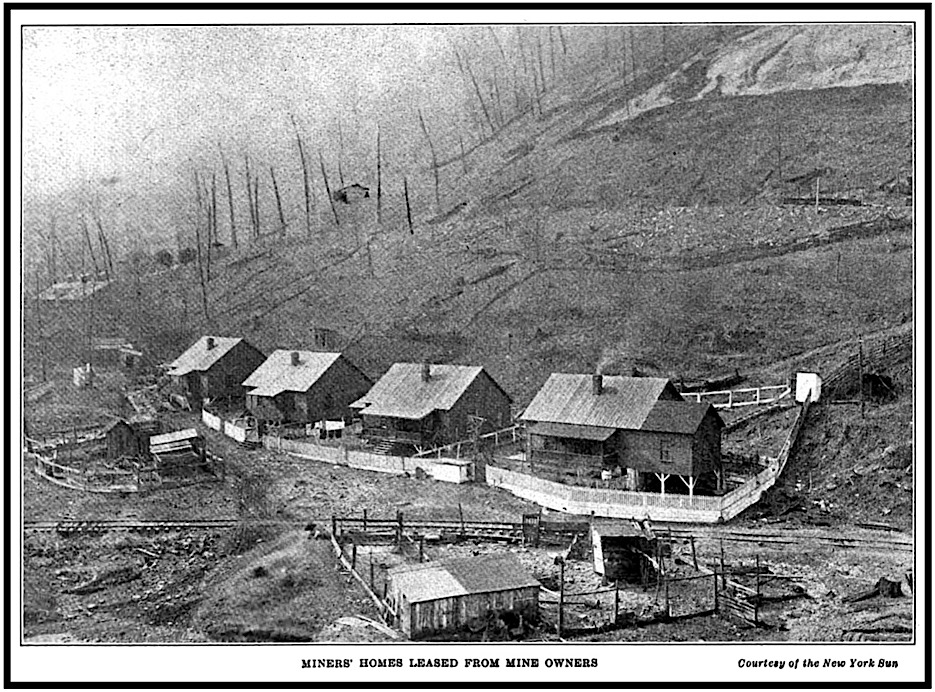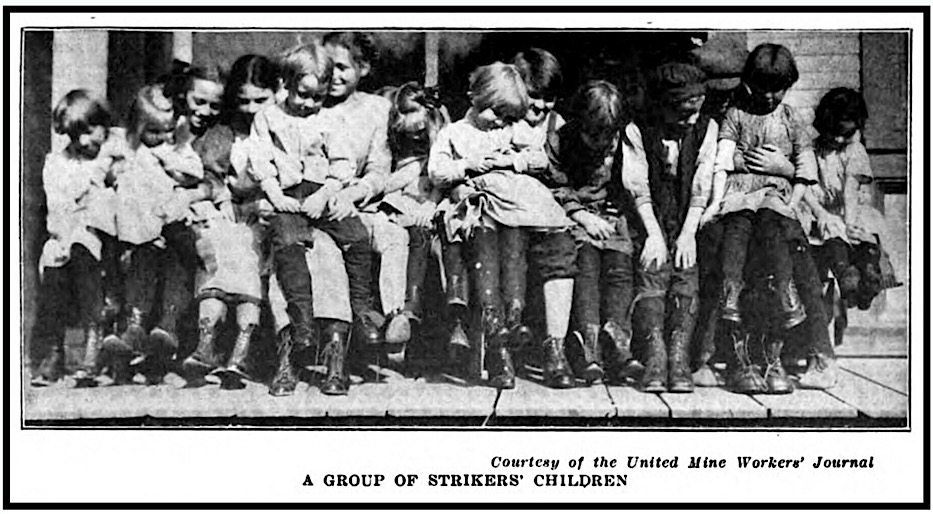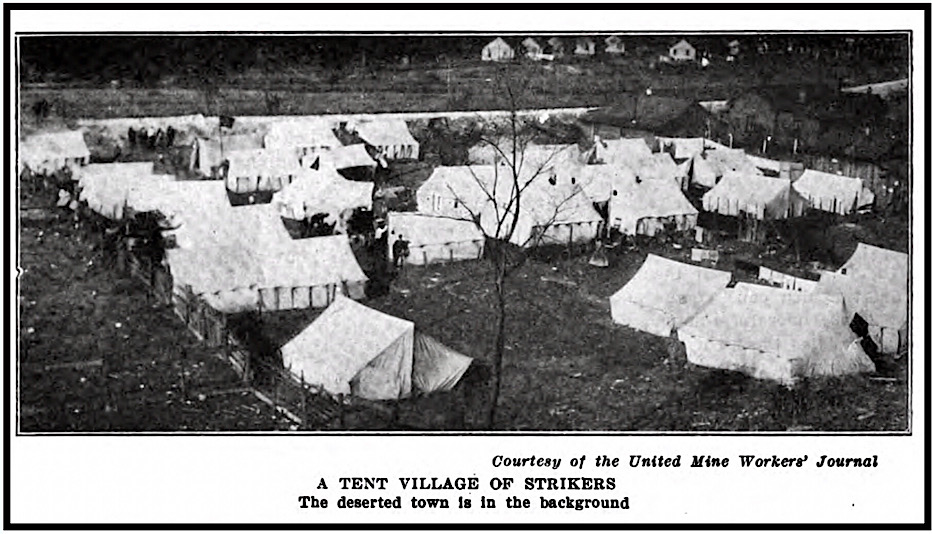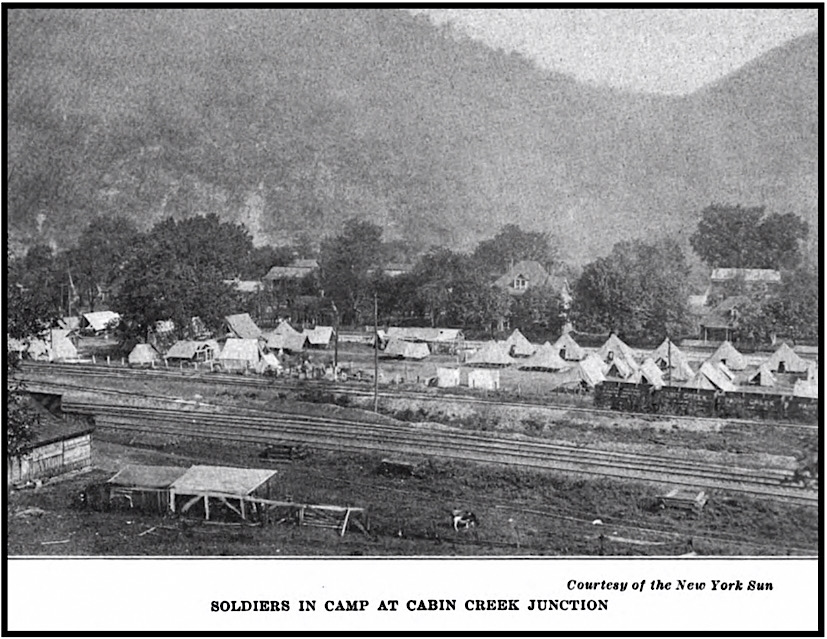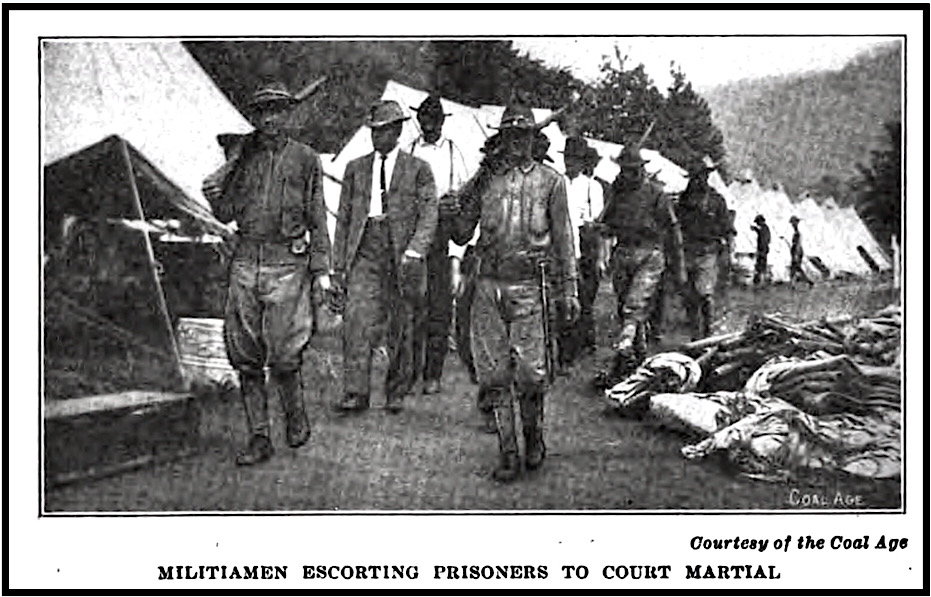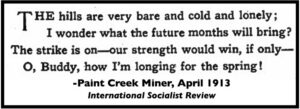 —————
—————
Hellraisers Journal – Wednesday April 9, 1913
“Civil War in the West Virginia Coal Mines” by Harold E. West
From The Survey of April 5, 1913:
FOR nearly a year a state of turmoil amounting in practical effects to a civil war has existed in the coal fields of West Virginia. The situation centers in the Kanawha Valley, hardly more than twenty miles from Charleston, the capital of the state.
The military power of the state has been used with only temporary effect; martial law has been declared and continues in force; the governor of the state has been defied and denounced from the state house steps and within his hearing; men and women have been thrown into prison and are still there for espousing the cause of the miners, and the grim hillsides of the canons in which the mines are situated are dotted with the graves of men who have been arrayed against one another in this conflict between capital and labor…..
[U. S. Secretary of Labor William B.] Wilson charged that a condition of peonage existed in the mines and that men were held there by force and compelled to work against their will. The coal operators denied this vehemently, at the same time fighting bitterly a federal inquiry. Evidence I was able to gather on a trip of investigation to the mines convinced me that a form of peonage does, or did exist; that the miners were oppressed; that the rights guaranteed under the constitution were denied them; that the protection of the law of the state was withheld from them and the law openly defied and ignored by the coal operators……
The State at Stake
It is hard to tell just how many men have been out in recent months. Five thousand would be a fair estimate. And remarkable as it is, these men have been able to hold out through a winter-and winters are severe in those West Virginia mountains-and they enter the spring and long season, when cold does not fight them from the ranks of their opponents, full of cheer and determined to continue the industrial war in which they have engaged.
It must be remembered that this fight is not simply one between miners and operators on Paint and Cabin Creeks. It is localized there, but every miner and every operator in the state is involved more or less directly. It is really a fight for the unionizing of the entire coal fields of West Virginia, now largely non-union…..
The Miners Guard
These mine guards are an institution all along the creeks in the non-union sections of the state. They are as a rule supplied by the Baldwin-Felts detective Agency of Roanoke and Bluefield. It is said the total number in the mining regions of West Virginia reaches well up to 2,500. Ordinarily they are recruited from the country towns of Virginia and West Virginia, preferably the towns in the hill country, and frequently have been the “bad men” of the towns from which they came. And these towns have produced some pretty hard characters. The ruffian of the West Virginia town would not take off his hat to the desperado of the wildest town of the wildest west……
When a man joins the Baldwins he “picks up his gun,” and that stamps him forevermore with his former associates if they were of the laboring class as an enemy and a man who has turned his back on his class and his kind…..
Beginning of Hostilities
Preparations for the warfare, which began in April of last year, had been going on for months before the actual opening of hostilities. The miners on Paint Creek began buying old Springfield rifles….. The miners had received information that the operators would repudiate the union and bring in the guards.
Their information proved correct. When the Kanawha Operators’ Association met to consider the scale, the Paint Creek operators declined to sign it and withdrew from the association. The miners struck and the guards appeared over night……
Miners were evicted from their homes and many of them have since been living in tents furnished by the United Mine Workers. Machine guns were imported and mounted in concrete fortifications that were hurriedly built in positions of vantage in the hills. Whisky, cartridges, rifles and machine gun ammunition were brought in large quantities.
The strike spread at once to Cabin Creek and from the beginning the warfare has been more serious on Cabin Creek than it has been on Paint Creek. More machine guns were established on Cabin Creek than had been planted in Paint Creek. The situation grew so threatening that Governor Glasscock ordered out the militia early last August at the solicitation of the mine owners….
When I left the field (1) the conflict was still on. It seemed likely to continue until one side or the other gave in. The presence of the military could only bring about a peace that is temporary. Having held out through the winter, the miners were preparing to hold out through the spring and summer and autumn if necessary, and the United Mine Workers of America were preparing to back them up with all the resources of the national organization.
(1) Since the writer left the district an unavailing effort was made to secure from the civil courts and order restraining the military commission from conducting the trials of those held on charges of participation in various deeds of violence in connection with the strike. Later, however, Governor Hatfield who, as head of the military forces of the state, has the power to review the acts of the military commission, discharged from custody a majority of those held.
Recently negotiations have been carried on between the miners’ union and one of the large companies involved in the strike with the result that there is a possibility of a settlement being effected in that quarter, though the matter remains in status quo until the return from the tropics of the president of the company. Recently some of the troops have been withdrawn from the strike zone, though martial law is still in force.
[Emphasis added.]
~~~~~~~~~~~~~~~~~~~~~~~~~
SOURCES & IMAGES
Quote Ralph Chaplin, WV Miners Longing for the Spring, Leaves, Paint Creek Miner, ISR p736, Apr 1913
https://www.marxists.org/history/usa/pubs/isr/v13n10-apr-1913-ISR-riaz-ocr.pdf
The Survey
(New York, New York)
-April 5, 1913, pages 37-50
“Civil War in the West Virginia Coal Mines”
-by Harold West
https://babel.hathitrust.org/cgi/pt?id=uc1.32106015659722&view=2up&seq=81
See also:
Note: The article by West is long and covers the following subjects in detail:
History of Miners’ Struggles in Coalfields of Kanawha County, West Virginia
Profits: Mine or Men?
State of the State, especially Paint and Cabin Creek Coalfields
The Mine Guards
Beginning of Hostilities, April 1912
Martial Law
Landlordism, Industrial Feudalism
Demands of the Striking Miners
Peonage
Glasscock Commission
Tag: West Virginia Court Martial of Mother Jones + 48 of 1913
https://weneverforget.org/tag/west-virginia-court-martial-of-mother-jones-48-of-1913/
Tag: Paint Creek-Cabin Creek Strike of 1912-1913
https://weneverforget.org/tag/paint-creek-cabin-creek-strike-of-1912-1913/
~~~~~~~~~~~~~~~~~~~~~~~~~
Paint ‘er Red – Monsieur Jack
Lyrics by Ralph Chaplin

